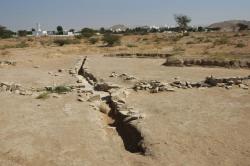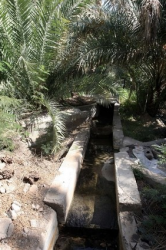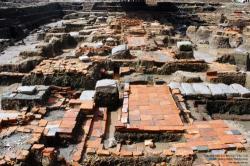INSTITUT SUPERIEUR D'ANTHROPOLOGIE
INSTITUTE OF ANTHROPOLOGY
ONLINE COURSES / COURS A DISTANCE
WINTER TERM : JANUARY 2015
REGISTER NOW
UAE – 
 Al Ain- Archaeologists, heritage experts and researchers revealed that the UAE was among the first countries in the world to create the water systems known as falajs, and to create human settlements thousands of years ago. At the Conference on Water and Life in the Arabian Peninsula, experts stressed that the history of oases and falajs in the eastern region of Abu Dhabi and the impact of water on the building and architecture of ancient human settlements represent a global human wealth. The conference, sponsored by Abu Dhabi Tourism and Culture Authority and held at Al Qattara Arts Centre this week, shed light on the effects and the heritage of water in the region and the role that the Hajar Mountains had in the formation of groundwater reserves in the Ard Jaw plain. Dr Walid Al Tikriti, head of the archaeology department at the TCA, presented a paper on irrigation systems and the impact of water on civilisations in the Bronze and Iron ages. He showed how water was the main factor in determining the shape of human settlement in the region. He discussed architectural elements and archaeological findings that remained from those two civilisations. Six falaj systems discovered in Al Ain and north of the city were associated with permanent and semi-permanent human settlements dating from the Iron Age and prove that south-east Arabia was a key area for this type of irrigation and that Al Ain and Al Buraimi oases originated from this system
Al Ain- Archaeologists, heritage experts and researchers revealed that the UAE was among the first countries in the world to create the water systems known as falajs, and to create human settlements thousands of years ago. At the Conference on Water and Life in the Arabian Peninsula, experts stressed that the history of oases and falajs in the eastern region of Abu Dhabi and the impact of water on the building and architecture of ancient human settlements represent a global human wealth. The conference, sponsored by Abu Dhabi Tourism and Culture Authority and held at Al Qattara Arts Centre this week, shed light on the effects and the heritage of water in the region and the role that the Hajar Mountains had in the formation of groundwater reserves in the Ard Jaw plain. Dr Walid Al Tikriti, head of the archaeology department at the TCA, presented a paper on irrigation systems and the impact of water on civilisations in the Bronze and Iron ages. He showed how water was the main factor in determining the shape of human settlement in the region. He discussed architectural elements and archaeological findings that remained from those two civilisations. Six falaj systems discovered in Al Ain and north of the city were associated with permanent and semi-permanent human settlements dating from the Iron Age and prove that south-east Arabia was a key area for this type of irrigation and that Al Ain and Al Buraimi oases originated from this system
http://www.thenational.ae/uae/uae-among-first-to-create-water-systems-known-as-falajs
VIET NAM –  Thang Long -A series of traces revealing the most sufficient evidence of cultural layers dating from the 11th century to 20th century have been detected in the Kinh Thien Palace of the Thang Long Imperial Citadel’s central section. According to information released by the Thang Long-Hanoi Heritage Conservation Centre and the Institute of Archaeology at a seminar in Hanoi on December 16, recent archaeological excavations in the section uncovered major architectural vestiges of the Ly Dynasty (the 11th century) and dynasties afterwards, including wall foundation, brick-paved yard, especially a big water supply and drainage system. Besides, excavators unearthed parts of the Palace, overlapped by cultural layers of the Le So (1428-1528) and Le Trung Hung (1533-1789) dynasties. Architectural traces from the Tran Dynasty (the 13th century) were also found, but they were damaged seriously. Most of archaeological findings are various kinds of architectural material, especially green and yellow glaze roofing tiles of the Le So period. Phan Huy Le, Chairman of the Vietnam Association of Historical Sciences said the results of the excavations do not only help specify cultural layers but also show where the centre of the Citadel is, and provide a comprehensive view on the architecture of the Citadel. At the seminar, representatives from the Centre and the Institute suggested further archeological excavations towards the relic site’s East to discover more architectural vestiges in the time ahead. The Thang Long Imperial Citadel was built in the 11th century by the Ly dynasty, marking the independence of the Dai Viet. The Royal Citadel’s central section was listed in UNESCO's World Heritage Site on July 31, 2010.
Thang Long -A series of traces revealing the most sufficient evidence of cultural layers dating from the 11th century to 20th century have been detected in the Kinh Thien Palace of the Thang Long Imperial Citadel’s central section. According to information released by the Thang Long-Hanoi Heritage Conservation Centre and the Institute of Archaeology at a seminar in Hanoi on December 16, recent archaeological excavations in the section uncovered major architectural vestiges of the Ly Dynasty (the 11th century) and dynasties afterwards, including wall foundation, brick-paved yard, especially a big water supply and drainage system. Besides, excavators unearthed parts of the Palace, overlapped by cultural layers of the Le So (1428-1528) and Le Trung Hung (1533-1789) dynasties. Architectural traces from the Tran Dynasty (the 13th century) were also found, but they were damaged seriously. Most of archaeological findings are various kinds of architectural material, especially green and yellow glaze roofing tiles of the Le So period. Phan Huy Le, Chairman of the Vietnam Association of Historical Sciences said the results of the excavations do not only help specify cultural layers but also show where the centre of the Citadel is, and provide a comprehensive view on the architecture of the Citadel. At the seminar, representatives from the Centre and the Institute suggested further archeological excavations towards the relic site’s East to discover more architectural vestiges in the time ahead. The Thang Long Imperial Citadel was built in the 11th century by the Ly dynasty, marking the independence of the Dai Viet. The Royal Citadel’s central section was listed in UNESCO's World Heritage Site on July 31, 2010.
http://english.vietnamnet.vn/fms/art-entertainment/118994/more-vestiges-found-in-thang-long-citadel.html
FRANCE –  Castillonnès -Sujets de sa Gracieuse Majesté, les Whetton se souviendront de ces travaux de décembre.Joli cadeau de Noël pour le couple : à la suite d'un repérage concernant le tournage de «Si seulement tue «produit par Douze films et programmé fin avril 2015, cinquante trois ans après «Tout l'or du monde» interprété par Bourvil et Noiret, les propriétaires de L'hôtel Du Cours de Thomazeau datant du XVIIIe siècle aménageait une pièce pour construire le décor d'une ancienne cuisine dans une remise a découvert une poche en soie dans un mur à 1,20 mètre du sol. Il l'a ouverte, pour y découvrir une quarantaine d'écus. Une première expertise faite sur place les date de 1492, époque d'Henry IV. Outre la valeur financière, la trouvaille a une richesse historique indéniable.
Castillonnès -Sujets de sa Gracieuse Majesté, les Whetton se souviendront de ces travaux de décembre.Joli cadeau de Noël pour le couple : à la suite d'un repérage concernant le tournage de «Si seulement tue «produit par Douze films et programmé fin avril 2015, cinquante trois ans après «Tout l'or du monde» interprété par Bourvil et Noiret, les propriétaires de L'hôtel Du Cours de Thomazeau datant du XVIIIe siècle aménageait une pièce pour construire le décor d'une ancienne cuisine dans une remise a découvert une poche en soie dans un mur à 1,20 mètre du sol. Il l'a ouverte, pour y découvrir une quarantaine d'écus. Une première expertise faite sur place les date de 1492, époque d'Henry IV. Outre la valeur financière, la trouvaille a une richesse historique indéniable.
http://www.ladepeche.fr/article/2014/12/17/2013367-ils-decouvrent-un-tresor-pendant-des-travaux.html